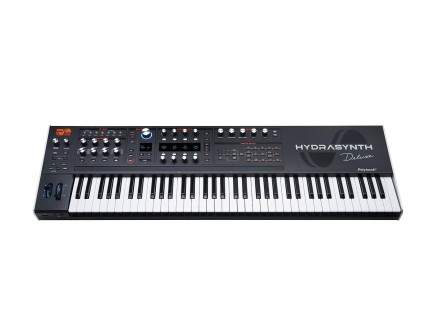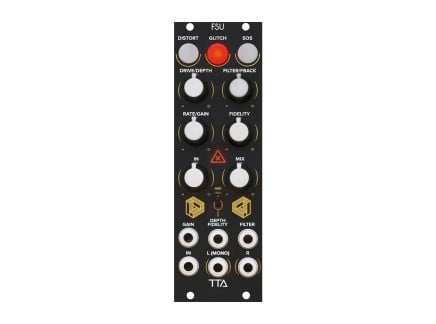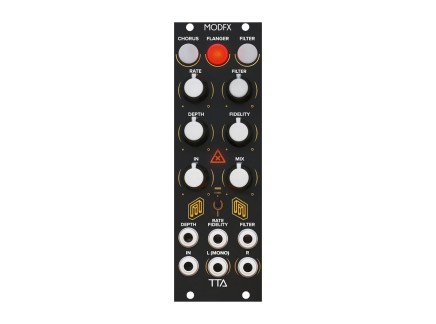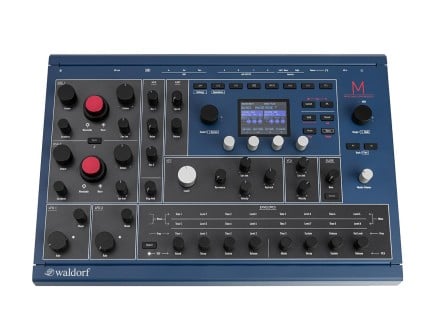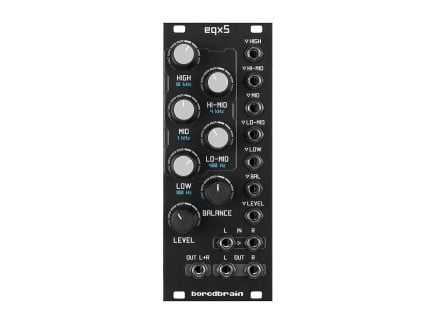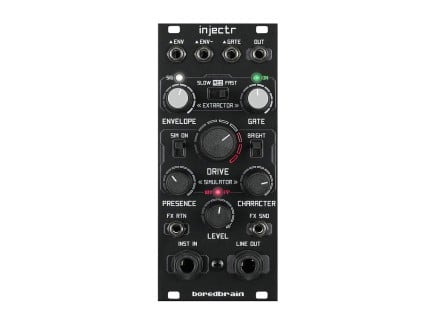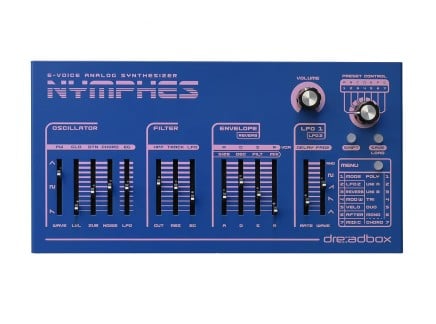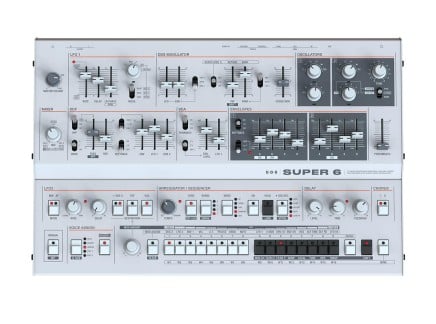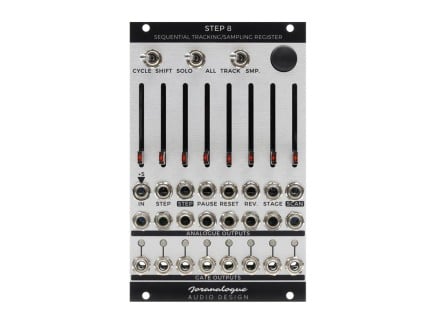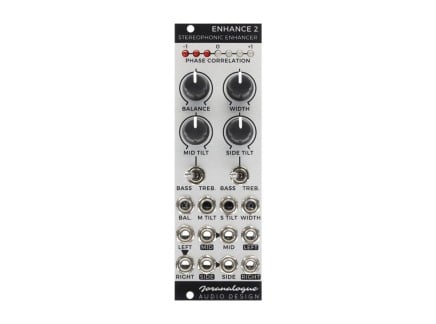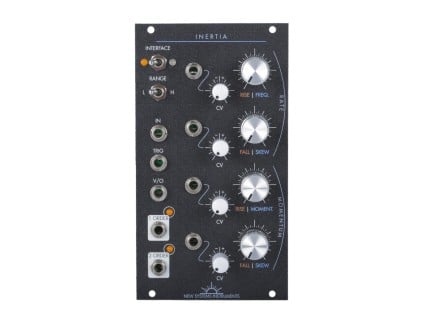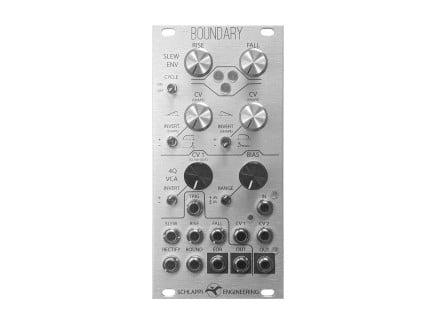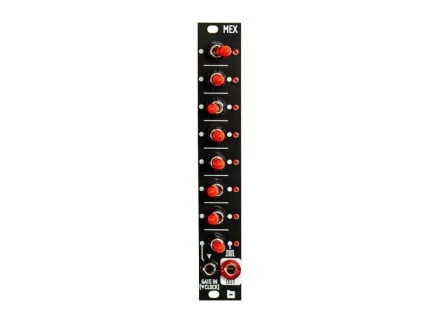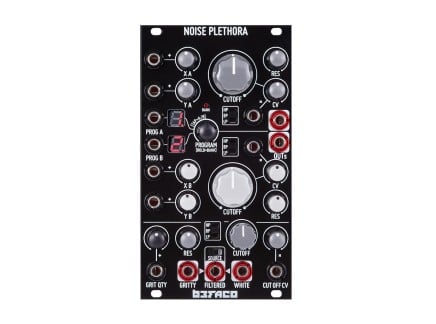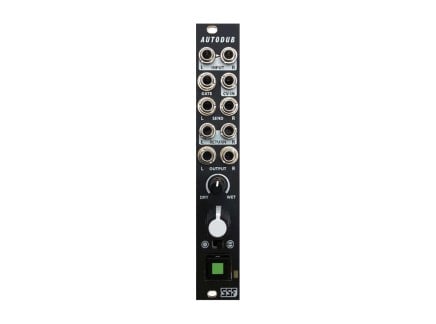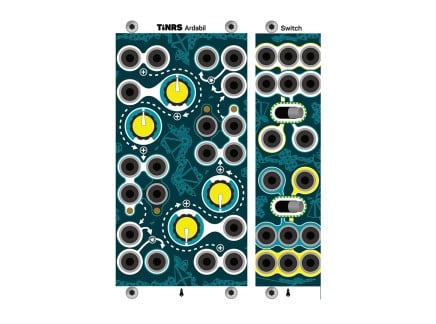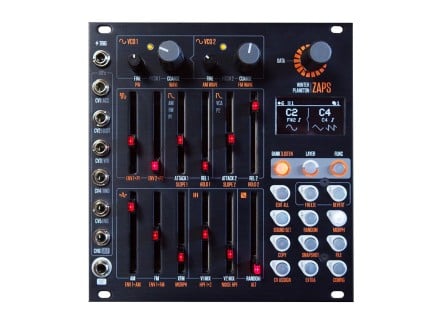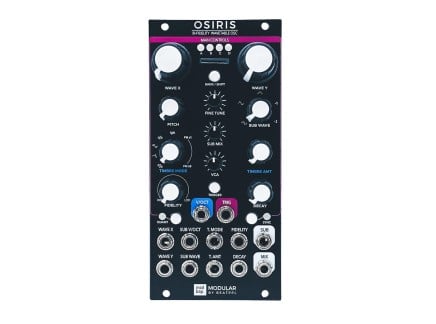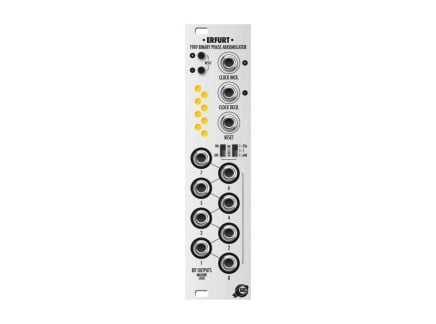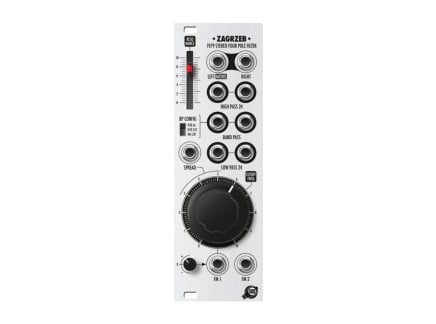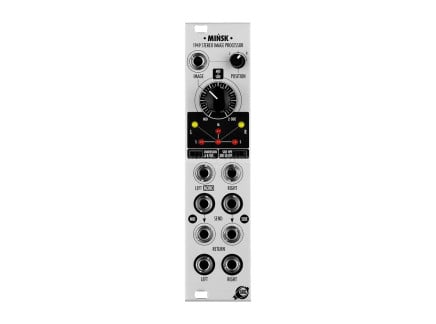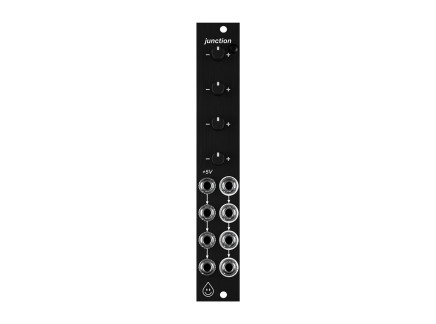Superbooth has returned for the first time since a pre-pandemic 2019—but given how the show has been going so far, it's clear that the world of synthesizer development hasn't been resting. A much-needed opportunity for synth manufacturers to show what they've been working on the past couple of years, Superbooth 2021 has already revealed a ton of exciting new developments.
Knobcon in Chicago already revealed several exciting releases from companies like ASM and others, but now we're seeing synth announcement season in full force, with Eurorack-format Buchla modules, a desktop format UDO Super 6, a new Erica Synths drum machine, and much much more. We'll continue to update this article as Superbooth continues, so be sure to come back and check it out. For now, here's some of the gear we're most excited about.
Welcome to the Family: ASM Hydrasynth Explorer + Deluxe
It shouldn't come as a surprise that we at Perfect Circuit love ASM's Hydrasynth—it's no doubt one of the most powerful synthesizers to be released in years, capable of everything from wavetable and virtual analog sounds to generative patches, outrageous FM, and plenty of sounds unlike any synthesizer I've ever heard. In fact, many of the staff at Perfect Circuit are proud owners of a Hydrasynth keyboard or desktop. And as such, we are beyond excited to see two new members of the Hydrasynth family: the Hydrasynth Explorer and Hydrasynth Deluxe.
Each of these new models utilizes exactly the same synthesis architecture as the prior iterations, and essentially the same user interface. This is a particularly exciting point, because the Hydrasynth's UI is arguably one of its strongest points altogether: using a grid of "Module Select" buttons that represent the synthesizer's internal signal path, it's remarkably fast not only to navigate the synth engine, but also to make modulation matrix assignements, macro controls, to randomize or initialize any subset of parameters, etc. Despite its depth of programming potential, the Hydrasynth never feels intimidating to use—it has an immediacy that makes it easy to forget how truly complex an instrument it is, and we consider that a very good thing.
Hydrasynth Explorer takes this sound engine and packs it into a small and surprisingly affordable package: a mere $599 at the time of writing this article. What's most surprising to me is that really, the Explorer doesn't seem to cut many (if any?) corners. ASM isn't the first synth company to release a more compact version of a flagship instrument (Korg MS-2000>Microkorg and Alesis Ion>Micron come immediately to mind)—but often, these efforts result in an instrument with a severely compromised user interface and significant changes to internal features. The Hydrasynth Explorer, though, seems to maintain basically everything: the exact same synthesis engine, eight voices of polyphony, the same navigation structure, the same CV output options, the same size modulation matrix, etc. In fact, it even has polyphonic aftertouch on its mini-keybed...the first time such a keybed has been implemented, as far as I know. The Explorer does have some diffences in build and lacks the CV inputs and expression pedal input of the other models, but all in all, it's incredible to consider that such a powerful instrument can be so small. Now, it is a bit wider than the Desktop model Hydrasynth (in fact, it's basically exactly the same size as a Microkorg), but we anticipate that it will be a welcome addition to many setups for the sake of its portability, affordability, and its sheer sonic potential. It truly is still a Hydrasynth...just a bit smaller and cuter.
But when ASM makes an announcement, it's usually big news—you know, like 73-keys big. And this is the case with the Hydrasynth Deluxe—the new flagship member of the Hydrasynth family.
Hydrasynth Deluxe is a 73-key bi-timbral synthesizer with plenty of options for key splits and layering. Frankly, imagining what's possible with a bi-timbral Hydrasynth is a bit mindboggling...given how deep and rich the modulation matrix is, it's actually quite possible to make even a standard Hydrasynth do pseudo-multitimbral tricks. As with the Explorer, the Deluxe model maintains the exact same synthesis workflow and editing process, only in double, complete with color-coded backlighting for the module edit buttons and additional assignable outputs. It keeps the CV inputs and outputs of prior models, as well as the PolyTouch keybed. So yeah, it's basically two Hydrasynths in one, at still a surprisingly reasonable price. ASM keeps doing truly remarkable things with their instruments, and we're very excited to get our hands on these new instruments.
Buchla + Tiptop Audio Eurorack Collaboration
Buchla USA and Tiptop Audio announced the first results of an interesting collaboration, the 200t series: Buchla 200 Series modules in Eurorack format. Many have long wondered why Buchla hadn't dipped their toes into the bustling Eurorack ecosystem, instead sticking to their proprietary 200e format. Their initial release of Red Panel 100 Series reissues in Eurorack format resulted in several interesting modules, but for many, these modules didn't quite fit into the "Buchla ethos"—the 100 Series predated many concepts we consider critical in "West Coast" synthesis, such as looping envelopes, complex oscillators, lowpass gates, etc.
The 200t series, though, taps right into the core of the West Coast synthesis philosophy, offering new interpretations of some of Don Buchla's most iconic modules. The 258t and 292t should help get you to a Buchla-esque sound in no time: the 258t Dual Oscillator offers two oscillators with variable waveshape and deep, rich FM possibilities, while the 292t is comprised of four lowpass gates with an integrated signal mixer. The 281t Quad Function Generator contains four looping envelope generators with quadrature operation and internal analog logic, and the 245t is a four-output addressable five-step sequencer capable of an astounding range of interesting functions from crude quantization to straight-ahead signal sequencing. The 257t voltage processor allows for mixing, inversion, scaling, offset, and crossfading functions, and the 266t offers a new rendering of the Source of Uncertainty, one of Buchla's most important and peculiar designs: a multiple random voltage source capable of a huge range of functions from basic S&H to fluctuating randomness, several flavors of stepped random voltage, and more.

The user interface on some modules has necessarily been adapted in order to fit into a 3U Eurorack system, voltage levels have been adjusted to be fully Eurorack-compliant, and all connectors are standard 3.5mm jacks rather than Buchla's famous combination of banana and Tinijax. It remains to be seen just how similar these modules' circuitry is to the original designs; I expect that (even signal level adjustments aside) several changes are necessary to get everything working smoothly in the Eurorack ecosystem, but I do trust that Tiptop is fully capable of bringing this vision to reality.
These modules are scheduled to be released individually or in small groups across the next year or so, and while prices haven't been disclosed for all models, the target price of ~$200USD for the 258t Dual Oscillator and 281t Quad Function Generator leave me hopeful that these will actually wind up being fairly affordable. Given the rather high price tag associated with many alternatives (even those within Eurorack format), we're excited at the prospect of these new modules are are super excited to see and hear more as they develop. Buchla and Tiptop have also suggested plans for modules beyond these initial offerings, so who knows—perhaps someday we'll see a 259 Programmable Complex Waveform Generator or 248 Multiple Arbitrary Function Generator in Eurorack format as well!
... But Wait! There's More! Tiptop Audio's FSU and MODFX
Buchla modules weren't the only thing to come from Tiptop Audio this Superbooth! FSU and MODFX is the double-feature for Tiptop's new DSP effects modules to add to your Eurorack system, continuing the same compact and flexible format that their previous ZVERB, Z5000, and ECHOZ share. Each module shows off a mono input and stereo outputs with a general input gain and mix knob, easy to integrate for stereo shaping or as an end-of-chain module. The four main controls vary per effect, as each module offers 24 high-quality digital effects reflected upon a certain style, be it dynamic or time-based.
FSU is a much more rigid and catastrophic effects unit compared to the previously listed, including an enormous amount of mangling sound tools that are divided into three banks: Distort, Glitch, and SOS. The Distort bank is pretty self-explanatory in that it offers tonal and harmonic distortion in the forms of saturation, clipping, ring mod and frequency shifting. FSU really gets into weird territory with the next two banks, starting with Glitch, a bank of warping time, pitch, and more with stuttery chorusing, granular feedback, and much more. The SOS (Sound on Sound) bank is where FSU stands out as a module, capturing and playing back the input signal that is fed into the record head. The affected sound results in traditional varispeed tape loops, random granular artifacts, panning tape heads, and even a degrading plate reverb.
Much like the name suggests, MODFX offers three banks of modulation effects that expand any mono signal into a lush and wide stereo field filled with swirls and twirls. The 24 on-board effects are divided into three banks: Chorus, Flanger, and Filter. The Chorus bank offers a wide variety of traditional chorus' that make synths like the Juno and Solina series, including vibratos, ensembles, multi-voice chorus', and dimensions — these add instant depth and character to any sound processed to make them more pronounced in a stereo mix. The Flanger bank offers classic flanged sounds, widening Haas effects, and even some more playable effects like resonators and Karplus-Strong delay lines. The final bank, Filter, offers no high or lowpass options, but instead an unusual array of phasers, bandpass filters, formant filters and many more that will transform your sound into sculpted and distinct profiles.
Whether you're looking for gritty textures or flourishing audio modulation, FSU and MODFX are fantastic additions to spice up your modular rack. Both are available for preorder going for $200 USD.
Buchla's New Music Easel
The Tiptop Audio collaboration isn't the only news from Buchla, either: they've revealed a prototype of the much-anticipated revision of the classic Music Easel design. For many, the recently-released Easel Command has proven to be a perfect entry point into the weird and wonderful world of Buchla. A standalone instrument comprised of a 208C Stored Program Sound Source with extensive options for interfacing with other devices via MIDI or Eurorack-style CV/Gate, it has proven to be attractive to both Eurorack users looking for a different take on the modular experience as well as keyboardists and studio musicians looking to understand Buchla's unique perspective on how synthesis should work. Many, though, have been left wondering when the full Music Easel would return—and now, that seems imminent.

The original Buchla Music Easel was produced in the early/mid-1970s, pairing a 208 voice module with a 218 touchplate keyboard in a small suitcase: a portable-yet-powerful distillation of many concepts from Buchla's larger 200 Series modular instruments. It wasn't produced in great numbers, but it became a sort of iconic cult instrument, likely due to its combination of peculiar sounds and colorful design. The Music Easel was re-released with some modern modifications in 2013, but later discontinued due to complexities of design that prevented scalable production. Buchla USA has been hard at work correcting those complexities, though—first re-designing the 208 to be considerably easier to produce and more feature-rich (hence the Easel Command), and now turning their eyes to the other missing pieces: the enclosure and the 218 Touch Activated Voltage Source.
First displayed at Knobcon last week, this newest iteration of the Music Easel seems to feature a 10-space suitcase, housing the 208, 218, a breakout/utility module, and space for one additional Buchla-format module. The breakout/utility module appears to include all the MIDI/CV connections from the rear panel of the Easel Command, along with some extra connections pertaining to the 218 keyboard, some voltage processing utilities, and a section pertaining to preset recall for the 208—allowing users to recall patches at a moment's notice. We're told that there will be other options for this slot rather than the preset recall system (perhaps the stereo effects processor discussed at the 208c's introduction?); however, it seems that this breakout module's design is not finalized, and changes are still likely forthcoming.
The 218 keyboard does have some exciting additions—a new touchstrip a la Buchla 217 provides variable CV and pulse outputs, and the four-pad "preset voltage source" on the upper right hand side of the keyboard now includes a pulse output as well, turning the 218 into a considerably more flexible controller than before. While we were expecting something visually more similar to BEMI's previous version of the Easel, this new rendition does seem to offer a lot of promise. Target street price for the new Easel seems to be $3999 (without the preset management option), with orders opening later this year, and yes—Buchla has indicated that there will be an option available for Easel Command owners to purchase the case + 218 keyboard separately. Hopefully we'll see these out in the wild soon!
Classic Wavetable Synthesis: Waldorf M
Following in the desktop-sized footsteps of Kyra and Iridium, M represents a return to Waldorf's roots. Where its siblings respectively cover the synthesis territories of virtual analog and modern wavetable, granular, and physical modeling, the M very much continues in the vein of the classic Waldorf Microwave. Indeed, like its ancestor, the M has a digital heart of two wavetable oscillators that are then shaped by an analog filter and VCA. But M embraces many of the advancements in synthesizer production over the past 30 years, offering four-part multitimbrality, an incredible abundance of presets, and much more.
While we sometimes take the capability of modern processing power for granted, for the context of M, it's worth briefly reflecting on early digital synthesizer development. Between the release of the original Microwave in 1989 and the all-digital Microwave II in 1997, technology had substantially moved forward, allowing Waldorf to boost up the fidelity of its wavetable algorithms. While in terms of general technology this might make the second version objectively better, in the context of art and music both instruments continue to have their place.
Waldorf recognized this while developing the M, and rather than offering one style over the other, the oscillators can operate in the style of either Microwave. When set to Classic mode, the oscillators are rendered as they would be on the first Microwave—8-bit wavetables, no anti-aliasing, and even offering an optional version of the ASIC mixing bug found on the original. In Modern mode, wavetables are boosted to the quality of the Microwave II/XT, with 16-bit wavetables, 40kHZ sample-rate and bandlimiting, and the option for Ring Modulation and Hard Sync. There's effectively no limitation on using either mode in the context of Single mode patches, but in Multi mode, only the first part can be set to Modern mode.
But M is more than its oscillators! The analog filter is a luscious lowpass design based on the SSI2144, a modern revamp of the classic SSM2044 chip used in the PPG Wave 2.3. An onboard arpeggiator with a number of patterns and chord options enhances performability, and each of its eight-voices can be distributed in any way among the four multimbral parts, with four auxiliary outputs available for external mixing or effects processing. It truly brings the magic of the Microwave sound into a more modern, parameter-accessible package, and fits in nicely with the other members of the Waldorf family.
Bringing the Thunder: Erica Synths PĒRKONS HD-01
Erica Synths is bringing the roaring heavens to ground level with PĒRKONS HD-01, a thunderous hybrid-voice drum machine packed with tons of controls & connectability and coated in a well-suited electric blue enclosure. This beast sports four voices that can utilize one of three digital sound modes that pass through analog filtering and drive, giving you the best of both worlds in this hybrid setup. All eight parameters per voice can be automated via the very flexible four-track sequencer, offering clock multiplication/division per track and ratcheting and probability per step. You can save up to 64 patterns and 64 kits, but with an SD card for expandable memory, PĒRKONS takes away any hindrances of your creativity.
PĒRKONS provides onboard analog effects including a send per voice to a BBD for dark and crunchy tail and a master overdrive and optical compressor for smashing and gluing your drums together. To take sound design even further, you can take a direct output from each voice for processing through outboard gear and your DAW or for treating each voice as individual tracks in a live setting. Each voice and the master channel also has a send and return output with level control, perfect for adding your favorite pedals and other outboard gear to sculpt PĒRKONS to your taste.
Easy interfacing with MIDI I/O and analog clock I/O makes PĒRKONS an easy choice to interface with other synths, drum machines, or DAWs. Capable of so much with such a limited amount of voices to work with, we are eager to get a storm brewing with the PĒRKONS HD-01. Expected street price is $1999 USD, with orders opening later this year.
Integrated Musical Systems: Boredbrain Eurorack Modules
Boredbrain Music has been in the game for awhile, starting in the world of creative effects pedal routing, with their incredibly handy Patchulator, which led to the Optx, EQx5, and Injectr. All three offer helpful tools in bringing your Eurorack into the realm of other musical formats, whether it's easily bringing your computer into the flow, or injecting a guitar, and other instruments into Eurorack (or both), these modules can sculpt your signal to perfection.
The Optx is an 8-in/8-out ADAT lightpipe module that is designed to actually make use of that expansion port you forgot your interface has. Send CV and audio from your computer to your rack and then back again with ease. The Injectr feels close to the roots of Boredbrain acting as a line level booster, as well as an amp simulator that has a nice distortion circuit, and effects loop. The beautiful thing about the growing Eurorack field is that now, more than ever, there is a case to be made for a fully effects-based system. Getting your external signal into the rack, however, has always been a bit of a quandary. If you get your signal up to modular levels, you often sacrifice tone; try to then send that back into an amp and the signal might be too hot. The Injectr also has an envelope follower to give you a little more dynamism when interacting with your system: it's pretty rad. The EQx5 is a 5-band parametric, stereo EQ with CV control over all parameters. It's functional and a great way to carve out space in timbrally rich sonic space.
Mix with Friends: Bastl Instruments Buddy
Bastl Instruments have come up with a fantastic mixer module that can seamlessly integrate line level signals with Eurorack into one solid, stereo output: introducing Buddy, a four channel preamp stereo mixer. The top two channels, A and B, accept Eurorack audio signals and offer up to +6dB of additional gain and can be either mono or stereo signals. The bottom two channels, C and D, accept stereo line level signals and offer up to +20dB of additional gain to bring the signal up to Eurorack level at the output stage.
What's really neat about channels C and D is that it can accept stereo 1/8" TRS signals, which opens up to mixing gear like Roland's Boutique series, Korg's Volca series, Pocket Operators, or even a stereo headphone output from larger gear. It's also a great opportunity to mix in found sounds and live sounds from a handheld recording device and further process through your Eurorack gear. Buddys can be chained together to add more inputs for allowing more inputs and mixing straight from your Eurorack system. Bastl's Buddy makes friends easily with signals and brings them together for one heck of a time.
Ethereal and Vintage: Dreadbox Nymphes
The Dreadbox Nymphes is the newest member of their portable desktop synth line, following last year's model, Typhon. Nymphes offers six voices of analog polyphony with a classic subtractive synthesis layout of oscillator, filters, envelopes and LFOs for shaping leads, basses, pads, keys, and anything your heart desires. True analog warmth packed in a small form factor, each control has a normal state and at least one shift state for maximum control.
Nymphes showcases a variable analog waveshape oscillator and analog lowpass and highpass filters (separate by design) for a wide tonal palette to shape and sculpt. Two envelopes per voice, one LFO per voice and a master LFO make for plenty of modulation per patch, and additional features like pulsewidth modulation, glide, detune, and more take shaping and modulating to a whole new level. The only digital feature on board is the reverb, perfect for creating rich and ethereal diffusions to complement the pleasant intricacies and deviations analog has to offer. Unlike the Typhon's effects, the DSP reverb on Nymphes is made in house by Dreadbox.
What really takes this synth to a new level is the multiple ways you can set up how it's played—voicing types include full polyphony, two different unison modes, tri, duo, mono, and a seventh mode called chord, where you can set up seven programmable chords to perform. Adding mod wheel, velocity, and aftertouch modulation sources with USB or 5-pin DIN MIDI inputs makes Nymphes a very performable synthesizer, and all features (including programmed chords) are savable per preset with up to 49 available preset slots. Portability is also made accessible not only by its size and rugged build, but also by being bus-powered, capable of integrating with your laptop or setting up with a portable battery.
Made from a place of love and support towards women everywhere during some of the most pressing times, Nymphes brings accessibility and portability of analog polyphony with a pricetag of $599 USD ready for preorder.
Small and Full: Super 6 Desktop from UDO
The Super 6 from UDO has been a popular, beautiful sounding synthesizer and it only makes sense to produce a desktop version, and they did just that with a compact version of their full size synthesizer. No corners have been cut, or features left out: this is the same synthesizer sans keyboard, plus if you have a Super 6 already, you can double your voices by chaining them together. It's sized to fit in a 19" rack and has VESA mounts on the bottom, so that extra monitor stand in your closet can finally be used. They even went through the trouble of having bespoke sliders manufactured at a smaller scale, so it will feel like the full size version. The release of this unit also marks a forthcoming major firmware update to the existing Super 6.
If you're unfamiliar with the Super 6, it is a Roland-inspired binaural, 12-voice, polyphonic, analog-hybrid synth with a true stereo signal path. The oscillators are DDS (direct digital synthesis), FPGA-based oscillators capable of classic waveforms with the first oscillator capable of 16 user-editable wavetable shapes. Both go through an analog signal path, filter and amp, for some added warmth. The unique thing is that the left and right have their own discrete signal path that can be modulated together for rich, wide sounds.
Triple the Fun: Moog Sound Studio - Mother-32 + DFAM + Subharmonicon
Moog's newest installation of the Sound Studio series comes with the ultimate trio of their mother ecosystem: the Sound Studio - Mother-32 + DFAM + Subharmonicon. Stacking the full lineup of their semi-modular synths with three-tier rack ears, a summing mixer, a cable holder, and tons of fun and functional additions makes the new Sound Studio the most immersive Moog experience you could ask for. Themed in a playful and colorful way, every item added to complement this Sound Studio is to continue the idea of carnival and amazement that the wonders of synthesis has to provide.
Create intriguing melodies and basses with the Mother32, push out banging and experimental drums and percussion with the DFAM, and put out polyrhythmic and oddly chordal sequences with the Subharmonicon. With their semi-modular design, all three instruments can not only patch with one another to stay in time, but also push each other into different territories. Subharmonicon can patch FM to Mother-32 with one of its various oscillators while sending clock information to jerk the DFAM sequence, and DFAM can use its pitch out to control Mother-32's filter while also using its velocity out to control the division of a polyrhythm on the Subharmonicon. The possibilities are all up to your imagination and how you express your creativity.
However, if you're new to the world of modular synthesis or are feeling extra exploratory, Moog has provided a wonderful set of material to get patching. Included comes an educational book of exercises and patches to understand these instruments better. The Sound Studio also provides a set of fun desktop games that can be great for traversing the art of patching by yourself or with friends. Additionally, the Sound Studio also comes with amazing artwork tailored to fit the entire experience, along with some more utilitarian but still aesthetically pleasing items like a dust cover to keep your gear clean and protected and a four channel summing mixer that also distributes power to each synth.
Running for $1999 USD, this newest addition of the Sound Studio is sure to bring a fantastical world of sonic exploration to your fingertips.
Analog Goodness Straight out of Belgium: Joranalogue's New Modules
In an increasingly digital world, Joranalogue have been consistently producing some of the most intriguing analogue designs in the world of Eurorack, equally covering the ground of basic utilities combined with adventurous takes on essential components of synthesis. For Superbooth this year, they've shown once again that analog electronics are still valid in 2021 with not one, but three incredible new designs.
First up, Enhance 2 promises to be the perfect tool to manage all of those cool stereo modules and effects to come out in the past few years. Panning and stereo Width are its most basic functions, but it also operates as a Mid/Side encoder/decoder, with handy tilt filtering available for the Mid and Side components. This works exceptionally well for polishing a mix with focus in the center and tidying up messy frequencies on the sides, and also opens the door to external Mid/Side effects processing.
Next is Orbit 3, which is an analog model of a double-scroll-style strange attractor. If you imagine the movement of a particle in 3D space around two points of equilibrium, Orbit 3 serves as a source of chaotic modulations and audio-rate oscillations, ranging from pure instability to fairly periodic repetitions. Chaos is different from pure random, as it is deterministic and certain settings impart repetition and predictability, with a wide range of territory to explore beyond that.
Finally, Step 8 is Joranalogue's long-awaited take on sequencing, and in the same way the Filter 8 and Generate 3 turned the idea of filtering and oscillation on their head, this module is sure to do the same. Specifically, they call Step 8 a "Sequential Tracking/Sampling Register," which is quite the mouthful. But in looking a bit deeper, it actually makes perfect sense—a 1:8 multiplexer, like in a sequential switch, routes a single input to eight channels, but instead of just going straight to an output, each stage also contains a highly precise sample/track-and-hold. This means that once another stage becomes active, the previous voltage can remain held for up to several minutes. Add in shift register functionality, reversible advance direction, and the ability to address stages with a continuous voltage, Step 8 is patch programmable in the truest sense—its open-ended functionality allows it to fill different roles depending on how it is patched.
Joranalogue is currently presenting all three of these modules at Superbooth, and estimates to begin shipping each sequentially from late 2021 to early 2022, with orders opening up as soon as more details become available.
Newton Enters Modular: New Systems Instruments Inertia and Headphone Amp
Bringing physics to the world of modular, Inertia is New Systems Instruments' newest module, offering multi-functional movement to add to your Eurorack system. Inertia is able to act as an envelope generator , LFO/VCO, filter, LFO divider, slew limiter, and much more. With an all analog design loosely based on the Serge Dual Universal Slope Generator, Inertia showcases two function generators in series. The first provides your typical rise and fall features and can process any input signal, be triggered as an envelope and be controlled via a 1v/oct input to pitch track as a cyclical and skewable waveshape. Inertia shines where no other module has gone and incorporates a second function generator named "momentum", where it pushes the original function past its intended target until it returns to its original destination (Newtonian!).
The two outputs produce a first and second order signal that follows the constraints of the rise and fall attributes or the value and skew attributes of each function if switched to the alternative interface. For complex signal processing or modulation, Inertia's main rise and fall/value and skew controls can be manually or CV controlled with additional attenuverters to dial in precise modulation. This can produce some interesting results such as ADSR-like envelopes and skewable filter resonance, making Inertia something to behold in the world of function generators.
Along with Inertia, New Systems Instruments have developed a Headphone Amp in the Intellijel 1U format. With low noise, low distortion, and capable of driving any headphones (upwards of 600 Ohms), the Headphone Amp is a great way to monitor any path of your modular system, be it a starting point or a stereo mixdown. You can currently preorder Inertia for $329 USD and the Headphone Amp for $89 USD.
Schlapp-happy with Boundary from Schlappi Engineering
Schlappi Engineering showed off their Boundary module, a cycling slew and 4 quadrant multiplier VCA. You really cannot have enough functions or enough VCAs, and the Boundary gives you both. One of the handiest things is that the slew/envelope is normalized to the VCA with an invert switch making it easy to create ducking effects. The Slew input is scaled for V/Oct so it will track accurately. The build quality is outstanding with thick, substantial knobs that make it easy to dial in the right values.
Two unique inputs the Boundary has are the Bound and Rectify inputs. Rectify does what its name says and inverts negative signals; it's also well suited for envelope following. Bound allows for interesting modulation effects, including a bouncing ball envelope shape by replacing the slew threshold. This thing is just a whole lot of fun and adds a good deal of functionality to any rack.
Beefy Noise from Befaco: Noise Plethora and MEX Expander
New from Befaco are the Noise Plethora and an expander for their Muxlicer module called the MEX. Their Muxlicer has been a wonder for straight-forward sequencing and switching, but lacked the ability to select which steps fire out gates. The MEX fixes that and essentially adds an additional All Gates output with eight switches letting you choose which steps fire out a gate. These little expanders are also chainable.
Noise Plethora is a very nifty three channel noise generator. The first two channels are identical and will be shipping with 40 different selectable noise algorithms ranging from crispy hisses to more tonal sounds. The third channel has three separate outputs: a white noise, a grit—which can be tuned to be dense clouds of particles to sporadic crackles—, and a filtered output that can use one or both of the aforementioned. Each channel has its own analog, multimode filter that is CV controllable.
Playable Tiny Friend: Autodub from SSF
Steady State Fate has released their latest offering: a compact interactive effects module called the Autodub. Inspired by the effects usage popularized by Augustus Pablo, King Tubby, and Lee Scratch Perry, where you momentarily feed bits of audio into a high-feedback delay for dreamy, psychedelic trails of repeats, the Autodub gives you a large button to make that possible. Practically speaking, the button opens up a stereo VCA in an effects loop and provides clickless audio when using it. When you engage the button, it also sets the Gate output to high, so you can trigger an envelope, freeze effect, burst generator, or whatever you want.
The inputs are DC-coupled so you can use this in less conventional ways by playing modulation signals instead. You could even use it to drastically switch the patch by changing the button behavior to Toggle, instead of Momentary. There's also a CV In, which controls the Send VCA and gets engaged when the button is pressed, making the possibility for more dynamic interaction. This thing is also just 4hp, so it won't take up too much space but can add a lot of functionality and interactivity.
Scintillating Oscillations: Poly Cinematic Oscillator from Knobula
Knobula debuted their first module, the Poly Cinematic Oscillator—and it is a substantial, polyphonic, full-voice sound source. It can use up to 56 oscillators across eight voices with their supersaw—offering 7 oscillators per voice—showcasing this very nicely. There's also a square and tonewheel waveform option, both of which also sound great. One of the most difficult things about polyphony in Eurorack, is that you often need a lot of modules to pull it off, but the PCO gives you an envelope and filter built right in, and at 12hp the size is just right.
To use the polyphony, however, you do need to use an external MIDI controller, but you can program sets of chords and sequence those with CV. If you want to use this as a voice, it can still function with a V/Oct and Trigger CV in, but you're limited to monophonic. The exciting thing about this, is that with a small case, like the 4MS POD, you could have a really, really tiny poly synth.
Weaving in the CV: Ardabil and Switch from TINRS
Utility has never looked this elegant. Ardabil by TINRS is a CV processor that uniquely follows two identical threads of CV and audio utilities. It offers a precision adder, attenuverter, offset, mult with additional inverted signal, and a VCA in a sequential order, respectively. What's exciting about this is you can inject CV signals at almost any point within the signal, be it at the top or bottom, and take from which point you need to end your CV processing. The identical channel is flipped upside down, giving you a unique look at each channel while also applying symmetry and sleekness to the design of the module.
Additionally, TINRS have provided a bundle that includes their new Switch module, offering two dual-gang switches that switch between three different input signals. Each Alpha lever switch, taken from their famed Fenix IV synthesizer, offers three way switching controlling two channels each. This module is completely passive, so it will not affect your signal in any way other than its intended purpose.You can preorder the Ardabil on its own for $214.99 USD or bundle it with the Switch for $239.99 USD.
Boom, Clap, Zoom, ZAPS by Winter Plankton
ZAPS is the lovechild of Winter Plankton, a combination of the renowned Winer Modular and Plankton Electronics, bringing stellar analog percussion with loads of digital controls to make the most of each parameter. The monophonic sound source is centered around two analog VCOs that offer a variety of waveshapes and noise to sculpt, processed through a high pass filter and VCA. ZAPS' signal is then shaped by amplitude and frequency modulation, taking an independent wave out from VCO2 or using VCO1 for XFM as the modulator — AM and FM tones evoke amazing tonal options for anything from subtle to abrasive textures. Handling amplitude, pitch decay and AM & FM shaping, ZAPS comes with two AHR envelopes that can be held out for sustained drums such as longer hi hats or 808s. The final sound is a mixed balance of both VCOs with a master high pass and an individual high pass on the noise oscillator within VCO2.
On its own, ZAPS' voice is pretty decent with a good amount of percussive modeling, but where ZAPS really shines is how it incorporates digital controls. On the memory side, ZAPS can store up to 12 banks that contain 12 slots of presets, where you can scan through each sound you design for resulting drum kits, percussive instruments, and so much more. For adding variety and interest to your sound design, you can inject randomness per parameter, to an entire slot, or to whole banks for generating percussive sounds that can land on some happy accidents. Want to create interest and variation without losing all your hard work? ZAPS can save snapshots of kits and recall them at any point, something that is amazing for live performance in combination with the "edit all" function.
To incorporate ZAPS with your entire modular setup, you have configurable CV connectors that can be inputs or outputs with a wide variety of CV ranges. CV inputs can control many aspects of ZAPS, such as slot position, accent, 1V/oct, and much more with internal attenuators to dial the perfect amount of modulation. An assignable "Alt" CV output can interface with the rest of your modular, great for making a macro control or controlling a send amount so you don't have to move your attention away from ZAPS.
Great for adding tons of percussive content to your modular system, ZAPS offers expansive digital control to bring you a versatile analog drum voice. ZAPS is available for preorder for $589.99 USD right now.
Hi Fi or Lo Fi? Osiris from Modbap Modular
Bringing a wealth of versatility once again for their second module, Modbap's Osiris is a bi-fidelity wavetable oscillator, capable of creating texturally versatile leads, basses, percussion and more. Offering two dimensions to scan through, Osiris provides 128 wavetables pre-loaded and offers OsirisEdit, a wavetable uploader software that you can add your own personal wavetables to Osiris via an microSD card. The oscillator is further processed through a timbre and fidelity section, where you are given six types of wave shaping and a bidirectional fidelity control to get mangled sync and FM tones that can be pristine hifi and dirty lofi. Osiris also has a VCA built in with a decay feature that you can trigger manually or externally, perfect for making percussive and plucky sounds.
Osiris comes with a sub oscillator that can be set to sine, square, triangle or a -1 or -2 octave shift of the main wavetable. What's really cool is you can either mix the sub into the final output or you can send it out the individual sub output along with controlling it's pitch individually with the sub 1V/oct input. This makes Osiris a flexible two-oscillator module that can create interesting paraphonic and duophonic textures. Additionally, Osiris provides wave reset on trigger via the sync button and pitch quantization via the quant button. It's clear that Modbap likes to make big moves in the modular world, but Osiris takes it to a whole other level. You can preorder Osiris now for $359 USD.
Stereo Savvy Superbooth: XAOC Devices Modules
With their track record of feature-filled Eurorack modules with a recognizable aesthetic, it should be no surprise that XAOC Devices showed up to Superbooth 2021 with a trio of stellar modules that are sure to see a lot of love when they start shipping.
First up, Mińsk is a hybrid analog/digital stereo image processor. Using on-board DSP, it can convert mono signals into faux-stereo, and it can also convert standard stereo audio channels into their Mid/Side components for polish and further processing. There's also internal highpass filters for the Side elements, with fixed cutoff frequency options at 50Hz and 300Hz. A different take on the same idea as the Joranalogue Enhance 2 that also debuted this year at Superbooth, both modules are sure to find homes in many of the increasingly stereo-centric Eurorack systems out there.
Speaking of stereo, XAOC also presented the Zagrzeb, a multimode stereo filter focused on performability. At only 8HP, it offers synthesists the bare essentials: stereo input, stereo outputs for lowpass, highpass, and bandpass responses, a big and tactile knob for controlling cutoff frequency, and a resonance slider. Even so, Zagrzeb has some tricks up its sleeve. Upon plugging in a mono input signal, an enhancement circuit creates a vivid stereo image, and a Spread CV input applies inverse modulations to the left and right filter cutoff frequencies. Additionally, the bandpass filter offers three slope configurations to skew it in favor of more high or low frequencies, or equal two-pole slopes around the cutoff.
Both the Mińsk and Zagrzeb should be available by the end of the year, but XAOC Devices did show one more module that's due for release at a later point. Erfurt, the latest member of their Leibniz subsystem of binary modules, is a divider centered around an internal eight-bit counter. When used standalone, it divides clock (or audio) signals by powers of two—that is, two, four, eight, 16, 32, 64, and 128. But connecting it to other members of the Leibniz system—Drezno, Lipsk, Jena—its capabilities extend dramatically.
Acid Rain's Junction and a Sneak Peek of Constellation
Seattle-based company Acid Rain Technology have long been developing Eurorack modules designed with performability in mind. While we recently said goodbye to their Switchblade module, they've come out with a handy four-channel attenuverter called Junction. It's capable of attenuating and inverting four individual signals, as well as cascading inputs and outputs together for a central signal management system in patch programmable fashion.
But Acid Rain shared a sneak peak of another module during one of Superbooth's live streams, an ambitious design that will pair nicely with Maestro as part of a tactile performance setup. Constellation is what they're calling a "Parametric Trigger and Gate Pattern Generator," based upon layered euclidean rhythms combined with logic and probability. There are eight channels, with dedicated CV inputs and trigger outputs, and each channel can layer together up to eight different euclidean patterns. These patterns can be combined in a number of different ways, such as additively or with boolean logic, or can be used to toggle an active gate state on and off. There's also ratcheting for gate bursts, and live mode functionality to mute or swap patterns on the fly. Acid Rain is still developing the module and adding new features, so we're keen on seeing it develop from here!
Horizontal's the New Vertical: Endorphin.es 1U series
Endorphin.es enters the 1U world with recreations of their amazing Cockpit, Milky Way, and Golden Master. Fit to match the 1U Intellijel standard, these wonderful modules are perfectly sized for routing mixes, inserting effects, and adding multiband compression. The Cockpit 1U provides the same stereo mixing capabilities and sidechaining, but now has split channels 2 through 4 into dual mono inputs that're normalled left to right — you can also label these channels with permanent marker in the provided white label space above each channel. The Golden Master 1U and Milkyway 1U still provide the same great processing with control for control matching as the original 3U unit.
The redesign keeps cables decluttered and parameters accessible as the jacks are located on the bottom and the controls are toward the top of the modules. Included on the back of each module is a section for routing via jumper cables for less cable clutter on the front end. The Milky Way 1U provides a mix out that can jumper to other 1U modules or act as a connection straight to the I/O of any Intellijel case, and the Cockpit 1U and Golden Master 1U have an auxiliary input and a mix output for jumping between 1U modules and a stereo line output dedicated for the 1U Intellijel I/O. Additionally, Endorphin.es has created 1U Panels in 4 & 6 HP sizes to fill out the rest of your case and protect from dust and damage.
If you're looking for more tools to polish your modular sound in a 1U format, look to Endorphin.es in the near future. Current expected prices for each module are $200 USD.
Continuous Creation: Doepfer's Six New Modules
Doepfer continues to be as prolific as ever offering up six new products: five modules and one keyboard. The keyboard is designed to integrate using only one cable that powers and provides MIDI to a companion module. Portability is the main purpose behind this smaller, 37 key controller, and it was designed to fold into a case such as the A-100PBSW. While small, it is a semi-weighted, Fatar keyboard, so it feels quite luxurious.
As far as Eurorack modules go, the A-126-2 Frequency Shifter is one of the main focuses with two ring modulators, two dome filters, and the ability to fade between Up and Down shifts, this is a useful addition to the Eurorack-o-sphere. It works well with oscillators and audio signals to create strange sci-fi textures and other frequency shift delights. Another tasty offering is the A-149-4 Quad VC Random which is a very compact, 4hp, 4-channel random voltage generator. It takes in up to 4 triggers which shoot out a random, selectable voltage when high. You can choose between octaves, oct+5th, chord, scale, semitones, or continuous (not quantized).
Rounding out the collection are a couple solid utilities: the A-182-4 Rotary switch is a 2-channel, bidirectional, passive selector module that sends one-of-four inputs to a single output, or vice versa. As well as the A-138f, a 2-channel crossfader that takes 3 inputs—audio or CV—and outputs them on a single channel. Inputs are faded using a rotary knob with A at full CCW, B at noon, and C at full CW. The last module is a light sensor with an onboard sensor, or the option to connect an external light sensor via patch cable to be placed wherever you want. You get a positive and negative CV output, as well as a gate out, with offset, level, and gate threshold knobs. Oh, all of these three are also just 4hp, so quite handy.



